The Edwardian House
 |
| Edwardian wall design, Spelter figures, chair and ewer |
The Edwardian period is also known in Australia as Federation. Houses built at this time draw on both Victorian and Queen Anne features. They follow a similar plan to Victorian houses. Many Mid-Victorian ornaments are still used, but houses are less ostentatious than in previous decades.[1] The houses are similar to Queen Anne, however they have less ornamentation.[2]
- The Edwardian era is classified by the reign of King Edward VII (1900-1910).
- As an architectural style, ‘Edwardian’ refers to the period 1901 to 1918.
As a period, it covers the years between 1901 and 1910.
Edwardian Houses (1890-1915)
Houses from the Edwardian era were built in line with expanding tram and rail routes and can be found in leafy inner and middle ring suburbs such as (in Victoria) Middle Park, Armadale, Hawthorn, Camberwell and Ascot Vale.
- Particularly sought-after Edwardian properties (the term Federation or, in some cases, Queen Anne may also be used to broadly describe the style) are found in Malvern’s Gascoigne Estate, Hawthorn’s Grace Park Estate and Camberwell’s Tara Estate.
- Either brick or weatherboard, such properties often have complex terracotta tiled roofs, wooden verandahs, stained glass window panels, and ornate plaster cornices and ceiling roses.
- Scott Patterson, director of Jellis Craig in Hawthorn, says there is a strong demand for Edwardian properties. “Anything built between about 1860s and 1920s is in strong demand.”
- Expect to spend $2 million to $2.5 million for an unrenovated property in Grace Park, with renovated properties starting at $3.5 million. In other less well preserved areas of Kew and Hawthorn, Edwardian properties can be snared for between $1 million and $2 million.[3]
 |
| Classic Edwardian home, except for the coffee table |
The beginning of the Twentieth Century experienced tremendous technological and social change. The wonders of the modern world, which had only sprang into being in the 1880s and 1890’s brought the first rewards of modern industrialization and mass-produced abundance. It was a time where Britain was at its imperial height and one in three of the world’s population were her subjects.
- On the other side of the Atlantic, Americans were experiencing new-found wealth and indulging in cuisine, fashion, entertainment and travel as never before.
- Perhaps the Edwardian era was best captured in the Titanic, the grand ocean liner which embodied human progress, opulence, and the excesses of the time.
The Edwardian era is viewed nostalgically and often called the “Gilded Age“. In Britain, it was a time of peace: sandwiched between the Boer War (1899-1902) and the First World War which broke out in 1914.
- In the words of Samuel Hynes, it was a ‘leisurely time when women wore picture hats and did not vote, when the rich were not ashamed to live conspicuously, and the sun really never set on the British flag’.
- It was also a time of great inequality, in which the privileges of the rich were made possible by the labour of their servants, an age when the inequalities of wealth and poverty were starkly delineated and the conventions of class were still rigidly defined – there was a place for everyone and everyone knew their place.[4]
 |
| Edwardian house in England, showing hallway furnished with a desk and even a fireplace surmounted by a mirror, with perhaps a bench seat to the right. |
Houses had wider frontages so there was often more room for a hall; in larger houses this was even used as a living room: for example, it would be furnished with a desk and perhaps even a fireplace.
- The underlying themes of buildings and interior design of the Edwardian era were for expensive simplicity and sunshine and air.
- Colours and detailing were lighter than in the late 19th century, looking back to the Georgian era of a century before. The desire for cleanliness continues.
- As gas and then electric light became more widespread, walls could be lighter as they did not get so dirty, and so looked better in the brighter light. Decorative patterns were less complex, both wallpaper and curtain designs were plainer. There was less clutter than in the Victorian era.[5]
Key features:
- Externally, it is common to see red bricks or painted weatherboards
- The roof is made from slate, terracotta, or corrugated galvanised roofing and is usually gabled in form, often with finials (decorative ornaments that emphasize the apex of the roof).
- Many Edwardian homes also feature roof shingles, which is a type of roof covering consisting of overlapping flat tiles.
- The windows are often timber framed and feature decorative leadlight.
- These houses also contain timber ornamentation to the external facade which is much simpler in design than Queen Anne homes.[6]
 |
| Corrugated iron edwardian house |
Outside:
- Roofs steeply sloped, usually hipped roofs with wide eaves, sometimes prominent, front facing gable ends
- Walls of red brickwork with flush joints, sometimes with cream painted render to base and gable ends or in bands on larger buildings
- Timber houses generally have square-edged or bull-nosed weatherboards, sometimes with incised weatherboards simulating blocks of stonework, painted cream
- Return L-shaped verandahs, roofed with corrugated bull-nosed metal and generally embellished with timber details including fretwork
- Windows often grouped
- Sunshades, supported by timber brackets, are common on the north and west
Garden:
- Fences commonly timber pickets, sometimes with a capping
- Palms used and occasional native plantings
- Lawns growing in popularity

Inside:
- Victorian period ornaments such as plaster cornices, ceiling roses, skirtings and architraves still popular
- Stained glass in front windows, featuring geometric and curvilinear shapes and sometimes native plants or birds
- After the heaviness, clutter and dark colours of Victorian interiors, people wanted something new and cheerful. Edwardian style was a breath of fresh air.
 |
| Edwardian style epitomised by Downton Abbey TV series |
- Style
- fresh and light
- informal, feminine
- bamboo and wicker furniture
- flowers and floral patterns
- pastel colours
-
Influences on Edwardian style
-
 |
| Mackintosh living room |
Art nouveau (c.1880 to 1910) Art nouveau could be said to be the first 20th century modern style. It was the first style to stop looking backwards in history for ideas, taking inspiration instead from what it saw around it, in particular the natural world.
 |
| Art nouveau needlework |
- When art nouveau was showcased first in Paris and then in London, there was outrage; people either loved it or loathed it. Within the style itself there are two distinct looks: curvy lines and the more austere, linear look of artists such as Charles Rennie Mackintosh. Some aspects of art nouveau were revived again in the 1960s.
Style
- sinuous, elongated, curvy lines
- the whiplash line
- vertical lines and height
- stylised flowers, leaves, roots, buds and seedpods
- the female form – in a pre-Raphaelite pose with long, flowing hair
- exotic woods, marquetry, iridescent glass, silver and semi-precious stones
Influences
- arts and crafts – art nouveau shared the same belief in quality goods and fine craftsmanship but was happy with mass production
- rococo style
- botanical research
The names
- Charles Rennie Mackintosh – architect and designer of furniture and jewellery
- Alphonse Mucha – posters
- Aubrey Beardsley – book illustrations
- Louis Comfort Tiffany – lighting
- René Lalique – glass and jewellery
- Emile Galle – ceramics, glass and furniture
- Victor Horta – architect
 |
| Mackintosh high-backed chair, silver picture frame, Mackintosh rose, Tiffany lamp |
- Get the look
- Floors – are parquet and should be stained and varnished.
- Colour schemes – are quite muted and sombre and became known as ‘greenery yallery’ – mustard, sage green, olive green, and brown. Team these with lilac, violet and purple, peacock blue. Mackintosh experimented with all-white interiors.
- Walls – can either be painted in one of the colours of the palette or off-white, or papered.
- Wallpaper – designs are highly stylised flowers, particularly poppies, water lilies and wisteria; branches, tendrils, leaves, stems, thistles, pomegranates; peacock feathers, birds and dragonflies.
- Tiles – use in panels and intersperse patterned ones with white. A technique called tube lining was used to make the design stand out from the surface – think of piping icing on a cake.
- Furniture – Mackintosh is renowned for extremely high-backed chairs in glossy black lacquer. If that’s not your style go for curvy shapes upholstered in a stylised floral fabric.
- Stained glass – panels went in doors as well as furniture – wardrobe doors, cabinets, mirrors etc, with curved leading for the stalks and leaves, ending in a flower made from pearly enamels or semi-precious stones such as amethysts.
- Door handles – beaten metal for door handles and light fittings are perfect for that handmade finish.
- Lighting – you’ve got to have a Tiffany lamp – the beautiful umbrella-shape rainbow of favrile glass with bronze and metal latticework. Original ones cost the earth but most of the high streets stores produce very good imitations.
- Fireplaces – look for cast iron hoods with the raised sinuous curves of flowers growing up each side and tiles. Many original ones can be picked up in salvage yards but make sure you know whether you’re buying a repro or an original. If you’re unsure whether a salvaged item is art nouveau, study the design carefully: it should grow from the ground upwards with a continuous organic movement.
- Ornaments – in silver, pewter and glass. There are hundreds of outlets selling Mackintosh-style clocks, frames, jewellery boxes etc. Typical art nouveau glass is iridescent with patterns of liquid oil. Lalique glass is usually a pearly opaque with etched designs.
- Flowers – and peacock feathers are the epitome of art nouveau style.
-
Influences on Edwardian Style
 |
| Arts and crafts living room |
Arts and crafts (c.1860 to 1910)
The arts and crafts movement was made up of English designers and writers who wanted a return to well-made, handcrafted goods instead of mass-produced, poor quality machine-made items. Inspired by socialist principles and led by William Morris, the members of the movement used the medieval system of trades and guilds to set up their own companies to sell their goods. Unfortunately, it had the reverse effect and, apart from the wealthy middle classes, hardly anyone could afford their designs.Visually, the style has much in common with its contemporary art nouveau and it played a role in the founding of Bauhaus and modernism.
 |
| William Morris wallpaper |
-
Style
- handmade
- simple forms with little ornamentation
- beauty of natural materials
- copper and pewter – often with a hammered finish
- stylised flowers, allegories from the Bible and literature, upside down hearts, Celtic motifs
- Influences
- medieval styles – the Gothic revival led by AN Pugin
- socialism – the ideas of John Ruskin and early Marx, especially the dehumanising effects of industrialization
- the Orient – the pared-down quality of Japanese art
- The names
- William Morris – set up own company with fellow artists called Morris, Marshall, Faulkner & Co in 1861, (later just Morris & Co), which produced everything from furniture and textiles to wallpaper and jewellery
- William de Morgan – glass, tiles and pottery
- CFA Voysey – wallpaper, textiles and silverware
- Richard Norman Shaw – architect
 |
| tapestry cushion, heart-shaped detail on copper mirror frame, arts and crafts chair, Morris wallpaper and blue and white china |
Get the look
- Furniture – should be wooden and handmade or at least look as if it’s handmade. Oak is the most used wood. Look for furniture with cut-outs of upside down hearts; other trademarks are copper and leather straps. Chairs have rush or leather seats.
- Floors – Wooden floors in either parquet or boards in oak give that rustic feel. Polish or stain them to a dark finish.
- Colour schemes – cream, terracotta, mustard yellow, olive green, deep blue and a deep crimson.
- Walls – these can be wood panelled but should be painted a dull green or greeny-blue.
- Wallpaper – is key. The originals used vegetable dyes and wood blocks. Today, there are literally hundreds of original William Morris designs still being manufactured by the major companies. Choose large-scale patterns with repeats. The firm Sanderson bought all the original printing blocks from Morris’s firm when it closed down.
- Fireplaces – If you have an original arts and crafts house, the fireplace probably still dominates the room. They had huge wide hearths set in an inglenook or recess. The mantelpiece was carved, often with a motto above it.
- Tiles – very similar to art nouveau ones but with brighter colours – cobalt blue, turquoise, greens and reds. Typical motifs include galleons and stylised flowers. They can still be picked up in salvage yards today or reproductions are available
- The Orient – add a touch of the Orient by adding blue and white china, palm leaf fans, screens, and oriental rugs.
- Stained glass – this was very popular, because of its medieval feel. Enlist a stained glass designer or if you just want a feel for it, try painting your own with some of the many glass paints around.
- Curtains and curtain poles – put up plain wooden or brass curtain poles. Curtains shouldn’t have any frills or flounces.
- Lighting – plain wall sconces are best for lighting.
- Flowers – decorate using simple flower arrangements or a potted house palm.
- Abide by William Morris’ s belief, ‘ Have nothing in your houses that you do not know to be useful or believe to be beautiful’.
-
Influences on Edwardian Style
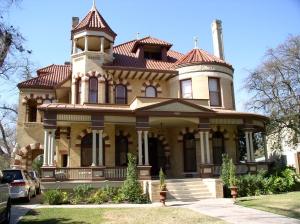 San Antonio, TX. The full spirit of the Queen Anne style is displayed here, with its picturesque (irregular) floor plan, and a jumbling of numerous other styles including romanesque and neoclassical.
San Antonio, TX. The full spirit of the Queen Anne style is displayed here, with its picturesque (irregular) floor plan, and a jumbling of numerous other styles including romanesque and neoclassical.
PERIOD OF POPULARITY: 1880’s – 1900 (1905 in the West).
IDENTIFYING FEATURES: Steeply pitched, irregular roof shapes; dominant, front-facing gable; patterned shingles, bay windows, picturesque massing (see Gothic Revival), polychromatic and decorative ornamentation; partial or full-width porches of one story; multiple gables and dormers; occasional towers and turrets, rounded or square. Differing wall textures are their “hallmark”. This is the most eclectic style of the Victorian era.
BACKGROUND AND INSPIRATION:The Queen Anne style represented the culmination of the picturesque, or romantic movement of the 19th century. Based on a premise of “decorative excess” and variety, there was little attempt to stay true to any one particular style or historical detailing. Rather, the style displayed a combination of various forms and stylistic features borrowed from the earlier parts of the Victorian and Romantic eras. The name of style suggested eclecticism (variety) to its proponents in England, from where the style originated. Still, “Queen Anne” is somewhat misleading given her much earlier reign (1702-1714) during times when Renaissance-inspired architecture was the norm. Richard Norman Shaw was the most prominent architect in England to promote the Queen Anne style, inspired as it was by a mix of earlier Tudor, pre-Georigan, and late medieval styles.
-
Edwardian: The names
- Thomas Sheraton – furniture – Thomas Sheraton (1751 – 22 October 1806) was a furniture designer, one of the “big three” English furniture makers of the 18th century, along with Thomas Chippendale and George Hepplewhite.
- René Lalique – glassware
- René Jules Lalique (6 April 1860, Ay, Marne – 5 May 1945, Paris) was a French glass designer known for his creations of perfume bottles, vases, jewellery, chandeliers, clocks and automobile hood ornaments. He was born in the French village of Ay on 6 April 1860 and died 5 May 1945. He started a glassware firm, named after himself, which still remains successful.
- Louis Comfort Tiffany – lighting[7] One of America’s most acclaimed artists, Louis Comfort Tiffany’s career spanned from the 1870s through the 1920s. He embraced virtually every artistic and decorative medium, designing and directing his studios to produce leaded-glass windows, mosaics, lighting, glass, pottery, metalwork, enamels, jewelry, and interiors. As the son of Charles Lewis Tiffany (1812–1902), founder of Tiffany & Company, the fancy goods store that became the renowned jewelry and silver firm, Tiffany chose to pursue his own artistic interests in lieu of joining the family business.
 |
| A drawing room in 1910 – photography Chris Ridley |
This represents the drawing room of a semi-detached house in Golders’ Green, one of the new suburbs of North London. These cottage-style houses included Arts and Crafts features such as a ‘living-hall’, oak fireplaces, simple mouldings and low ceilings. The French windows, which allowed direct access to the garden, ensured the room was light. Electric power was also a new feature in these houses.
 |
| A modern interior design based on the Edwardian style |
Exterior Colour & Design:
- Roofs usually terracotta tiles or corrugated metal often painted, sometimes slate
- Gable ends ornamented with roughcast or pebbledash, left natural and battens painted a dark colour
- Verandahs increasingly feature timber fretwork rather than cast iron lacework ornamentation
 |
 |
| Born in the 1920’s: Lurnea, 85 Oxley Road Hawthorn Vic |
Timber panelling and leadlight windows. |
|
 |
 |
| An original Edwardian kitchen |
|
 |
| Edwardian wall design, Spelter figures, chair and ewer |
Get the look
- Furniture– Edwardian furniture would have been reproduction furniture to them so you can choose from a range of styles including baroque, rococo and empire. The wing chair is a typical shape. Choose upholstery in chintz, and damasks in pale colours.
- The eclecticism of Edwardian furnishings, mixing classic lines with curvilinear details, gave rise to a new approach in interior design, one less rigid and more global than previously seen. Edwardian furniture is less about a specific design and more about a time of great change and new attitudes. Unlike his more reserved and less social mother, King Edward loved to travel and even took an interest in those groups that heretofore had been without influence, such as minority groups and women. The mixing of styles, the borrowing from past and creating new, the brightening and lightening of materials and design, all point to a celebration of the mixing of cultures and of classes.[8]
- Wicker – bamboo and wicker furniture were also introduced in these period. You can still buy good quality wicker furniture today in a range of colours. If you find some in a junk shop and it’s worse for wear, give it a new lease of life by spraying the paint on with a spray gun or aerosol. Don’t brush it on as you’ll clog up the weave.
- Floors – highly polished wood block floors, with oriental rugs, look fantastic in a living room. If you already have wooden floorboards, make sure they’re not yellowy pine as this will jar. Stain them with an oak-coloured varnish instead. For areas with more wear and tear, go for bricks in a herringbone pattern or red quarry tiles.
- Wallpaper – choose wallpapers with a fresh, cheerful feel such as florals of roses, lilac, wisteria, and sweet peas, with trellises, ribbons and bows. Stripes are also typical – go for something simple but rich for dining rooms such as a gold damask and white, and candy stripes for bedrooms. It was considered too much to have both a dado rail and a frieze: most people papered up to the dado rail and then papered or painted the wall above that with plain paper or distemper.
- Lincrusta – put up some lincrusta – embossed wallpaper – introduced in 1877. It has an almost rubber-like texture and comes in beautiful art nouveau designs. It is still being made today. It can be painted any colour although cream is probably best.
- Fireplaces – fireplaces are smaller than Victorian ones. They had splayed sides with projecting iron or copper hoods and decorative tiles. Smaller versions are usually found in the bedrooms.
The following illustrations were from www.moda.mdx.ac.uk/themes/1900s_style (site no longer found)
 |
| Crystal glass services, vases, and table decorations, china dinner and dessert services, china tea and breakfast services, toilet services |
|
 |
| Catalogue of linoleums |
|
 |
| Decorative suggestions |
|
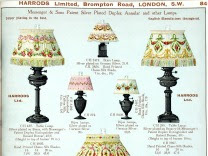 |
| China, glass & lamp department |
|
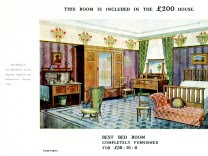 |
| Substantial and inexpensive furniture |
|
 |
| Encaustic and tesselated tiles, plain and ornamental wall tiles … art decorated tiles to order |
|
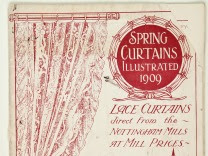 |
| Spring curtains illustrated 1909: Lace curtains direct from the Nottingham Mills at Mill prices |
|
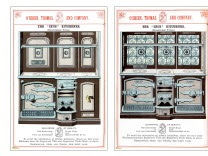 |
| Illustrated catalogue of builders goods manufactured and sold by O’Brien, Thomas and Company, Jan. 1893 |
|
 |
| Art & utility in gas fittings: > No. 326 |
|
Colour schemes – choose pastel colour schemes in the colours of flowers – primrose yellows, leaf greens, the lilac of wisteria, and grey. Living rooms can take darker colours such as dark green for fabrics and cream walls.
- Lighting – electric lighting was just beginning to be introduced to the grander homes. Buy fabric lampshades in soft colours with frills and tassels. Use them on wall lights, table lights and even standard lamps. For a central light, look for a pendant fitting in smoked glass. Ceiling roses disguised the wiring for light fittings. Tiffany lamps or reclining female bronze figures are also in keeping.
- Windows – hang pieces of lace at the windows and then add plain or floral curtains to co-ordinate with the walls. Alternatively put up a simple striped roller blind.
- Cushions – take up embroidery and needlepoint and make some cushions with floral motifs in an art nouveau style.
- Pictures – hang pictures on hooks but place them halfway down the wall.
- Accessories – add Edwardian-style accessories such as early gramophones (the ones with the conical shells), tiered silver cake stands, and pretty silver photograph frames.
- Flowers – echo the wallpaper with your choice of flowers. Try loosely arranged bunches of sweet peas, roses, and lilac. House palms are also typically Edwardian.
What to invest in
Gillow & Company were an English furniture company, founded by Robert Gillow (1704-72) in Lancaster about 1727. During the nineteenth century, Gillows became the leading manufacturers of furniture for the rising middle and upper class market due to the quality of the materials used and craftsmanship in manufacture.
 |
| Waring & Gillow Ltd, a wardrobe, c.1930 amboyna, coromandel 187… |
|
 |
| A Waring and Gillow stamped flame mahogany serving table with… |
|
 |
| Waring and Gillow, armchair, retaining original moss green… |
|
 |
| A pair of mahogany side tables by Waring and Gillow, circa 1900,… |
|
 |
| Superb 19th century Wm IV mahogany sarcophagus wine cooler with… |
|
 |
| A superb burr walnut breakfront bookcase, by Waring and Gillows… |
|
Where to see it
- The Argory, Moy, Dungannon, Northern Ireland. Tel: 028 8778 4753
- Polesden Lacey, Great Bookham, Surrey – National Trust stately home
- Shaw’s Corner, Ayot St Lawrence, Herts – Edwardian home to playwright George Bernard Shaw with virtually unchanged interiors
- Le Meridien Waldorf Hotel, London – tea dances in the Palm Court
- Museum of Domestic Design & Architecture, Middlesex
- Geffrye Museum, London
Further reading
- The Edwardian House by Helen Long (Manchester University Press)
- Edwardian House Style by Hilary Hockman (David & Charles)
- Care & Repair of Period Houses by Albert Jackson & David Day (Collins)[9]
- ^ http://heritage.vic.gov.au/Heritage-places-objects/What-house-is-that/edwardian.html
- ^ http://advice.realestateview.com.au/buying-investing/australian-architecture-styles/
- ^ http://news.domain.com.au/domain/real-estate-news/pricing-the-period-20101108-17jju.html
- ^ http://www.pbs.org/manorhouse/edwardianlife/introduction.html
- ^ http://www.housepursuits.co.uk/architectural.html
- ^ http://advice.realestateview.com.au/buying-investing/australian-architecture-styles/
- ^ http://www.bbc.co.uk/homes/design/period_edwardian.shtml
- ^ http://www.ehow.com/about_4596675_edwardian-furniture.html
- ^ http://www.bbc.co.uk/homes/design/period_edwardian.shtml














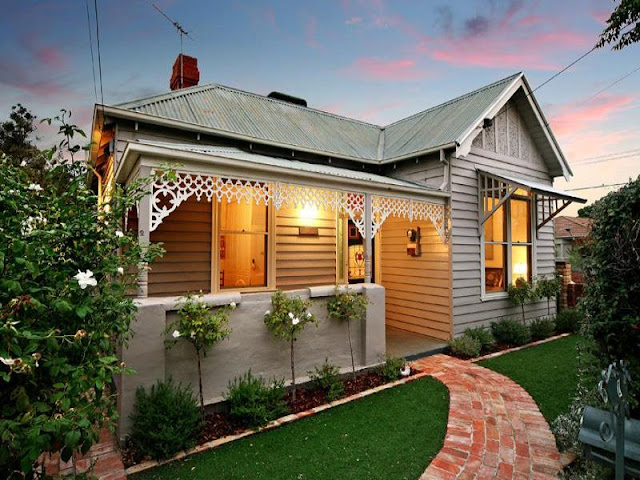



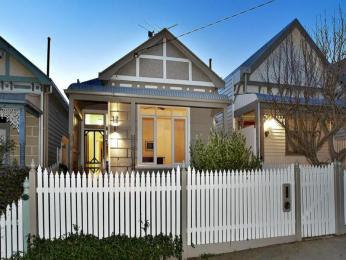
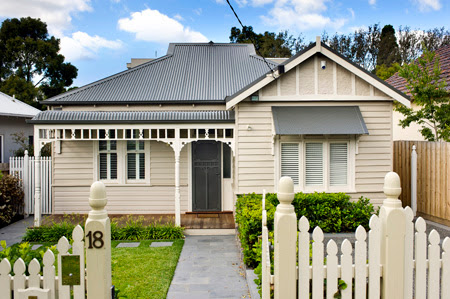







 San Antonio, TX. The full spirit of the Queen Anne style is displayed here, with its picturesque (irregular) floor plan, and a jumbling of numerous other styles including romanesque and neoclassical.
San Antonio, TX. The full spirit of the Queen Anne style is displayed here, with its picturesque (irregular) floor plan, and a jumbling of numerous other styles including romanesque and neoclassical.




























